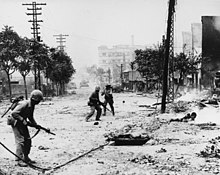|
Frank N. Mitchell
Frank Nicias Mitchell (August 18, 1921 – November 26, 1950) was an American who served in World War II as an enlisted Marine and was killed in action as a Marine first lieutenant during the Korean War while serving with the 1st Marine Division.[1] He posthumously received the United States' highest military decoration for valor, the Medal of Honor, for his actions as a platoon commander during a firefight with the enemy on November 26, 1950, at Hagsang-ni, near Yudamni in North Korea.[2] BiographyFrank Mitchell was born on August 18, 1921, in Indian Gap, Texas, to J.D. and Isabel Mitchell.[3] He was a 1938 graduate of Roaring Springs High School in Roaring Springs, Texas.[3] He attended Colorado College under the Navy V-12 program, Southwestern University, University of North Texas, and North Texas Agricultural and Mechanical College where he played football.[4][3] He married Beverly Banks and they had one daughter.[3] Mitchell enlisted in the Marine Corps in 1939. During World War II he served aboard the aircraft carrier USS Enterprise at Wake Island, additional service in the Marshall Islands, and occupation duty in China. He was also attached to Fleet Marine Force Pacific as a member of its rifle and pistol team. He was commissioned a second lieutenant in 1945.[4]  During the Korean War, First Lieutenant Mitchell was a rifle company platoon commander in Company A, 1st Battalion, 7th Marine Regiment, 1st Marine Division; the 7th Marines were activated on August 17, 1950, at Camp Pendleton. The 7th Marines and Mitchell, left Camp Pendleton and sailed for Japan on September 1. On September 21, the 7th Marines made an amphibious landing at Inchon, South Korea.[5] His regiment including the 1st Battalion, rejoined the 1st Marine Division which had made an assault landing at Inchon on September 15, and participated with the division in the battle of Seoul against North Korean forces.[5] On September 26, Mitchell personally led his platoon up a well defended hill and overtook the enemy.[6] He was awarded the Bronze Star Medal with Combat "V" "for heroic achievement in connections with operations against the enemy while serving with Company A... during the period 24 September 1950 to 4 October 1950".[6] The 7th Marines landed ashore next at Wonsan on October 27. Afterwards, the 1st Marine Division headed by the 7th Marines were directed to march into North Korea to Hamhung, their objective, the Chosin Reservoir, a man-made lake.[5] The 7th Marines were to proceed north of Hamhung to relieve a South Korean Army unit which had fought with Chinese Communist forces (two hundred thousand Chinese troops had entered North Korea on October 19 by secretly crossing the Yalu River, and launched an offensive on October 25). On November 2, the 7th Marines reached the South Koreans with little opposition (November 1 was the first confrontation between the Chinese and the U.S. military).[5] However, Chinese presence increased after this. On November 3, as Company A was in a defensive position near Hamhung, Mitchell's platoon was hit hard suddenly by the Chinese and almost overrun. Mitchell "rallied his men to repel the attack and he, although painfully wounded in the ensuing action, refused to be evacuated until the danger of a serious break-through was averted." He was awarded the Silver Star (posthumous).[6] On November 4, one of Mitchell's platoon's squad leaders, Sergeant James Poynter, during a bayonet attack against the Chinese, took out three enemy machine guns with grenades, thereby saving his squad and platoon during a hill fight (Hill 532) at Sudong, and was posthumously awarded the Medal of Honor.[5] On November 15, the 7th Marines and the 1st Marine Division completed their move north to Hagaru-ri, at the southern tip of the reservoir. The division was to proceed more north to Yudamni, on the western side of the Chosin Reservoir and to seize it, which was done with little resistance on November 25.[5] As Mitchell and A Company was on patrol south of Yudam-ni the next day, Mitchell's platoon which was on point, got hit hard by a Chinese ambush near the small village of Hagsang-ni which caused a fierce firefight with the Chinese and many casualties on his platoon. Lt. Mitchell immediately took action at the front of his platoon and shown "great personal valor and extraordinary heroism".[2][5] Despite being wounded, he personally sacrificed his own life to save the lives of the Marines which were wounded in his platoon, and the other outnumbered Marines in his platoon when they were being withdrawn. For his leadership and heroic actions during the enemy's attack and counterattack on his platoon that included hand-to-hand fighting, he was awarded the Medal of Honor (posthumous).[3] He was listed as missing in action and his remains were not recovered.[1][7] The Battle of Chosin Reservoir would begin on the night of November 27, when both the 7th Marines and 5th Marines were counter-attacked by a massive number of Chinese troops which would soon force the surrounded 1st Marine Division at Yudam-ni to begin their withdrawal from North Korea.[5] The Medal of Honor was posthumously presented to Mitchell's widow and daughter on his behalf by Lieutenant Colonel Henry D. Strunk, the acting director of the 6th Marine Corps Reserve District, at his widow's home in Atlanta, Georgia, on August 6, 1952.[3] "Mitchell Hall" at The Basic School in Camp Barret, Marine Corps Base Quantico, Virginia, is named for him.[8] Military awardsLt. Mitchell's military decorations and awards include the following: Medal of Honor citationThe President of the United States in the name of The Congress takes pride in presenting the MEDAL OF HONOR posthumously to
FIRST LIEUTENANT FRANK N. MITCHELL CITATION:
Silver Star citation (Army)
Bronze Star Medal citation
LegacyThe following have been named in honor of 1st Lt. Mitchell:
See also
NotesReferences
Information related to Frank N. Mitchell |
||||||||||||||||||||||||||||||||||||||||||
